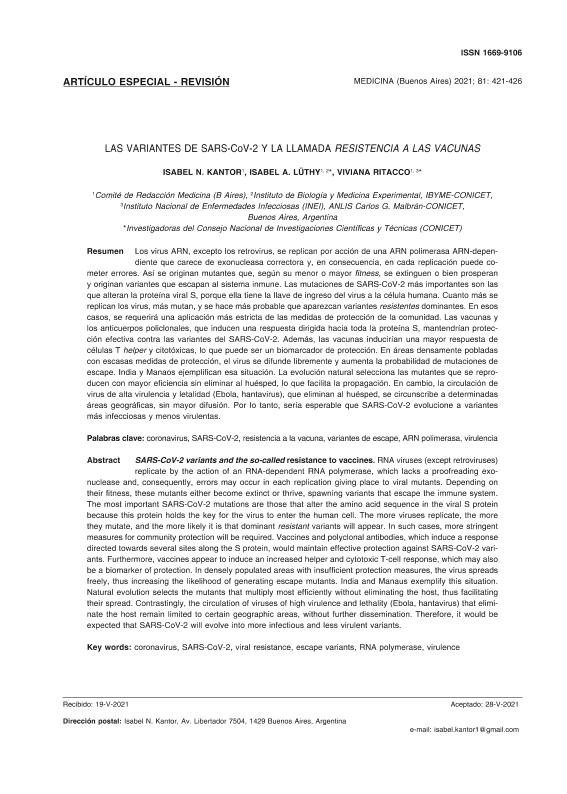Mostrar el registro sencillo del ítem
dc.contributor.author
Kantor, Isabel N.
dc.contributor.author
Luthy, Isabel Alicia

dc.contributor.author
Ritacco, Gloria Viviana

dc.date.available
2021-09-07T15:02:06Z
dc.date.issued
2021-06
dc.identifier.citation
Kantor, Isabel N.; Luthy, Isabel Alicia; Ritacco, Gloria Viviana; Las variantes de SARS-CoV-2 y la llamada resistencia a las vacunas; Medicina (Buenos Aires); Medicina (Buenos Aires); 81; 3; 6-2021; 421-426
dc.identifier.issn
0025-7680
dc.identifier.uri
http://hdl.handle.net/11336/139805
dc.description.abstract
Los virus ARN, excepto los retrovirus, se replican por acción de una ARN polimerasa ARN-dependiente que carece de exonucleasa correctora y, en consecuencia, en cada replicación puede cometer errores. Así se originan mutantes que, según su menor o mayor fitness, se extinguen o bien prosperan y originan variantes que escapan al sistema inmune. Las mutaciones de SARS-CoV-2 más importantes son las que alteran la proteína viral S, porque ella tiene la llave de ingreso del virus a la célula humana. Cuanto más se replican los virus, más mutan, y se hace más probable que aparezcan variantes resistentes dominantes. En esos casos, se requerirá una aplicación más estricta de las medidas de protección de la comunidad. Las vacunas y los anticuerpos policlonales, que inducen una respuesta dirigida hacia toda la proteína S, mantendrían protección efectiva contra las variantes del SARS-CoV-2. Además, las vacunas inducirían una mayor respuesta decélulas T helper y citotóxicas, lo que puede ser un biomarcador de protección. En áreas densamente pobladas con escasas medidas de protección, el virus se difunde libremente y aumenta la probabilidad de mutaciones de escape. India y Manaos ejemplifican esa situación. La evolución natural selecciona las mutantes que se reproducen con mayor eficiencia sin eliminar al huésped, lo que facilita la propagación. En cambio, la circulación de virus de alta virulencia y letalidad (Ebola, hantavirus), que eliminan al huésped, se circunscribe a determinadas áreas geográficas, sin mayor difusión. Por lo tanto, sería esperable que SARS-CoV-2 evolucione a variantes más infecciosas y menos virulentas.
dc.description.abstract
RNA viruses (except retroviruses) replicate by the action of an RNA-dependent RNA polymerase, which lacks a proofreading exonuclease and, consequently, errors may occur in each replication giving place to viral mutants. Depending on their fitness, these mutants either become extinct or thrive, spawning variants that escape the immune system. The most important SARS-CoV-2 mutations are those that alter the amino acid sequence in the viral S protein because this protein holds the key for the virus to enter the human cell. The more viruses replicate, the more they mutate, and the more likely it is that dominant resistant variants will appear. In such cases, more stringent measures for community protection will be required. Vaccines and polyclonal antibodies, which induce a response directed towards several sites along the S protein, would maintain effective protection against SARS-CoV-2 variants. Furthermore, vaccines appear to induce an increased helper and cytotoxic T-cell response, which may also be a biomarker of protection. In densely populated areas with insufficient protection measures, the virus spreads freely, thus increasing the likelihood of generating escape mutants. India and Manaus exemplify this situation. Natural evolution selects the mutants that multiply most efficiently without eliminating the host, thus facilitating their spread. Contrastingly, the circulation of viruses of high virulence and lethality (Ebola, hantavirus) that eliminate the host remain limited to certain geographic areas, without further dissemination. Therefore, it would be expected that SARS-CoV-2 will evolve into more infectious and less virulent variants.
dc.format
application/pdf
dc.language.iso
spa
dc.publisher
Medicina (Buenos Aires)

dc.rights
info:eu-repo/semantics/openAccess
dc.rights.uri
https://creativecommons.org/licenses/by-nc-sa/2.5/ar/
dc.subject
CORONAVIRUS
dc.subject
SARS-COV-2
dc.subject
RESISTENCIA A LA VACUNA
dc.subject
VARIANTES DE ESCAPE
dc.subject
ARN POLIMERASA
dc.subject
VIRULENCIA
dc.subject
COVID-19
dc.subject.classification
Farmacología y Farmacia

dc.subject.classification
Medicina Básica

dc.subject.classification
CIENCIAS MÉDICAS Y DE LA SALUD

dc.title
Las variantes de SARS-CoV-2 y la llamada resistencia a las vacunas
dc.title
SARS-CoV-2 variants and the so-called resistance to vaccines
dc.type
info:eu-repo/semantics/article
dc.type
info:ar-repo/semantics/artículo
dc.type
info:eu-repo/semantics/publishedVersion
dc.date.updated
2021-07-30T19:18:04Z
dc.identifier.eissn
1669-9106
dc.journal.volume
81
dc.journal.number
3
dc.journal.pagination
421-426
dc.journal.pais
Argentina

dc.journal.ciudad
Buenos Aires
dc.description.fil
Fil: Kantor, Isabel N.. Comité de Redacción Medicina; Argentina
dc.description.fil
Fil: Luthy, Isabel Alicia. Comité de Redacción Medicina; Argentina. Consejo Nacional de Investigaciones Científicas y Técnicas. Instituto de Biología y Medicina Experimental. Fundación de Instituto de Biología y Medicina Experimental. Instituto de Biología y Medicina Experimental; Argentina
dc.description.fil
Fil: Ritacco, Gloria Viviana. Comité de Redacción Medicina; Argentina. Dirección Nacional de Institutos de Investigación. Administración Nacional de Laboratorios e Institutos de Salud. Instituto Nacional de Enfermedades Infecciosas; Argentina. Consejo Nacional de Investigaciones Científicas y Técnicas; Argentina
dc.journal.title
Medicina (Buenos Aires)

dc.relation.alternativeid
info:eu-repo/semantics/altIdentifier/url/https://www.medicinabuenosaires.com/revistas/vol81-21/n3/421.pdf
Archivos asociados
